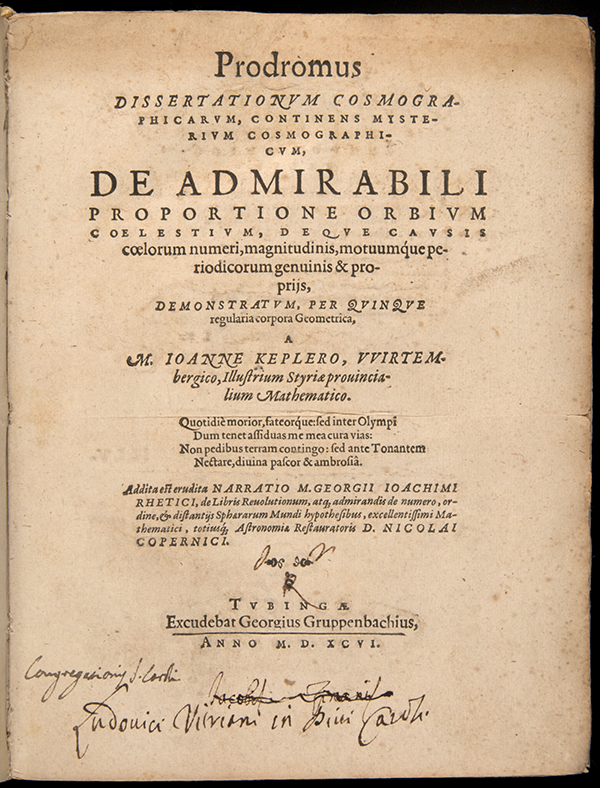- About MAA
- Membership
- MAA Publications
- Periodicals
- Blogs
- MAA Book Series
- MAA Press (an imprint of the AMS)
- MAA Notes
- MAA Reviews
- Mathematical Communication
- Information for Libraries
- Author Resources
- Advertise with MAA
- Meetings
- Competitions
- Programs
- Communities
- MAA Sections
- SIGMAA
- MAA Connect
- Students
- MAA Awards
- Awards Booklets
- Writing Awards
- Teaching Awards
- Service Awards
- Research Awards
- Lecture Awards
- Putnam Competition Individual and Team Winners
- D. E. Shaw Group AMC 8 Awards & Certificates
- Maryam Mirzakhani AMC 10 A Awards & Certificates
- Two Sigma AMC 10 B Awards & Certificates
- Jane Street AMC 12 A Awards & Certificates
- Akamai AMC 12 B Awards & Certificates
- High School Teachers
- News
You are here
Mathematical Treasure: Kepler’s Mysterium Cosmographicum

Above: Title page of Kepler’s Mysterium Cosmographicum
Johannes Kepler’s first major astronomical work was Mysterium Cosmographicum (Mystery of the Cosmos) published in 1596. Kepler was an astronomer, a strongly religious person, and also something of a mystic. Believing that God, The Great Mathematician, designed the universe, Kepler sought mathematical design in the heavens. In the Preface to his Mysterium, he wrote
I undertake that God, in creating the universe and regulating the order of the cosmos, had in view the five regular bodies of geometry known since the days of Pythagoras and Plato, and that He has fixed according to those dimensions, the number of the heavens, their proportions, and the relations of their movements.

Kepler’s model of the universe was based on the five Platonic solids. Realizing that each of these solids could be circumscribed and inscribed by spheres, Kepler obtained a family of nested spheres, which he fit to the geocentric theory of planetary motion then in vogue. A solid model of this Platonist polyhedral-spherical system is illustrated on page 24 (above) of the Mysterium.
Kepler expanded on his ideas about the geometry of the universe in 1619 in his Harmonices Mundi; see images from it in Mathematical Treasure: Kepler's Harmony of the Worlds.
The images above were provided through the courtesy of the History of Science Collections, University of Oklahoma Libraries, and the special considerations of Kerry Magruder, Curator, and Carilyn Livesey, Coordinator of the Collection. These materials may be viewed in their entirety at the History of Science Collections website.
Frank J. Swetz (The Pennsylvania State University), "Mathematical Treasure: Kepler’s Mysterium Cosmographicum," Convergence (November 2014)




